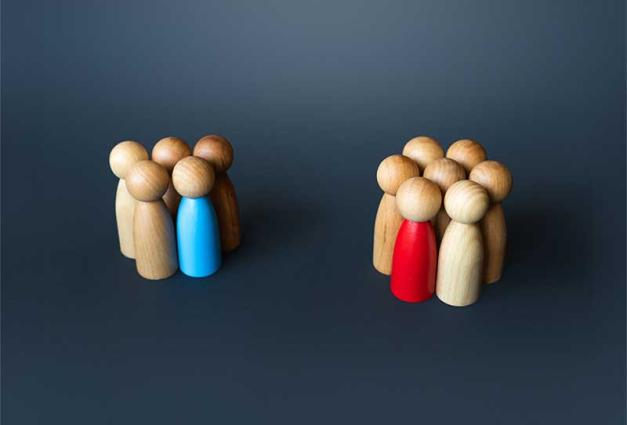Outrage over politics and politicians can incentivize media to report with political slants that increase political polarization. After Fox News called the 2020 U.S. presidential election for Joe Biden, Tucker Carlson wrote “I continue to think the company (Fox News) isn’t taking (this) seriously enough. We need to do something to reassure our core audience. They’re our whole business model.” Carlson was suggesting that Fox News should not call the election for the winner (Biden), but should instead play to their viewers’ beliefs that Trump won and that the election was not free and fair.
Many blame (social) media for polarizing people, spreading misinformation, and encouraging extremism, even political violence. But can the media also be a place for bridging political divides? We suggest the media can reduce political polarization by pairing personal experiences and the facts.
Personal Experiences Build Respect Between Political Opponents
Our previous research suggests that partisan respect can result from sharing personal experiences. An example would be “The reason I am pro-gun is due to my own experience of needing to use a gun in self-defense.” Importantly, these experiences are more effective in bridging divides than simply sharing facts, as in “The reason I disagree with you on gun policy is due to statistics in this gun policy report.” However, while experience sharing is a promising strategy, it’s still important to find ways to communicate the facts in a healthy democracy.
How the Media Can Bridge Divides
In our new research, we studied whether one can bridge divides through media coverage. Our goal was not only to explore whether the media can help reduce political polarization, but also whether one can communicate facts by combining them with experiences.
In one of our studies, American participants reported their stance on climate change, and then based on these responses we could determine who their political opponent was. For example, if someone reported being pro-climate policies, their opponent would be anti-climate policies. Participants read a news article supposedly from USA Today that discussed why a political opponent disagreed with them on climate change policies. Some participants learned the opponent disagreed based on personal experiences. As an example, participants who supported looser coal mining regulations learned the opponent disagreed because “due to looser coal regulations, a nearby coal mine polluted our water. My children drank the polluted water, got sick, and had to go to the hospital.” Other participants read about an opponent who disagreed based on facts. In this case, for example, participants who supported looser coal mining regulations learned the opponent disagreed because they “read in the Environmental Policy Report that due to looser coal regulations, 45% of coal mines are polluting waterways.” A final group of participants had an opponent who disagreed based both on these experiences and the facts.
Reading about someone’s personal experiences did indeed make a difference. Participants were significantly more tolerant and less willing to dehumanize their political opponents when they read about an opponent’s experiences or a combination of these experiences and facts.
We also conducted a similar study focused on social media. American participants reported their stance on gun policy, and based on these answers, we showed them a fictitious Facebook post from someone (that is, an opponent) who disagreed based on experiences, facts, or a combination of both. Again, we found that experiences alone, or combined with facts, were powerful in bridging divides and did so better than facts alone. Our research shows that both news media and social media can bridge divides and that it is possible to communicate the facts while simultaneously reducing partisan animosity.
Cross-Cultural Evidence
We also explored whether persuading people in this way is helpful in a different country—Germany. We found that the most polarized Germans viewed opponents more positively after reading a news article about that person’s experiences (or a combination of experiences and facts), compared to facts alone. However, less polarized Germans were not influenced. In the American studies, we had found that our persuasion method was equally effective for people who were more and less polarized.
Why did these cross-cultural differences emerge? We think it is due to the different political systems. In the United States politics is tribal (“us” versus “them”). This can lead both more and less polarized people to similarly feel cold towards the opposing party–making our persuasion method effective. In Germany, however, there are multiple parties with overlapping affiliations and belief systems—making politics less tribal. Therefore, less polarized Germans have more favorable attitudes towards opponents, making our approach less helpful. But for more polarized Germans (who dislike opponents more), hearing the experiences (or the experiences and facts) of political opponents is beneficial. Importantly, across all studies—in both the United States and Germany—this persuasion method was similarly helpful for both liberals and conservatives.
Media as a Context for Change
Our research suggests one should rethink the role of media in politics. Presently, the media can be blamed for making polarization worse, but the media can reduce polarization—with the right strategies. Having journalists report on people’s actual experiences that connect to divisive issues, or sharing your own personal experiences on social media, reduces political division. Importantly, the media can combine experiences with the facts to foster constructive partisan relationships and a healthier democracy.
For Further Reading
Kubin, E., Gray, K., & von Sikorski, C. (2023). Reducing political dehumanization by pairing facts with personal experiences. Political Psychology. https://doi.org/10.1111/pops.12875
Kubin, E., & von Sikorski, C. (2021). The role of (social) media in political polarization: A systematic review. Annals of the International Communication Association, 45(3), 188-206. https://doi.org/10.1080/23808985.2021.1976070
Kubin, E., Puryear, C., Schein, C., & Gray, K. (2021). Personal experiences bridge moral and political divides better than facts. Proceedings of the National Academy of Sciences, 118(6), 1-9. https://doi.org/10.1073/pnas.2008389118.
Emily Kubin is a post-doctoral researcher at RPTU Kaiserslautern-Landau and the University of North Carolina at Chapel Hill. She has published work on political polarization, bridging political divides, and the media.
Kurt Gray is a Professor of Psychology and Neuroscience at University of North Carolina at Chapel Hill where he directs the Deepest Beliefs Lab and the Center for the Science of Moral Understanding. He has published work on morality and bridging political divides.
Christian von Sikorski is an Assistant Professor of Political Psychology in the Institute for Communication Psychology & Media Education at RPTU Kaiserslautern-Landau. He has published work on how the media affects people’s attitudes and beliefs about society and one another.



